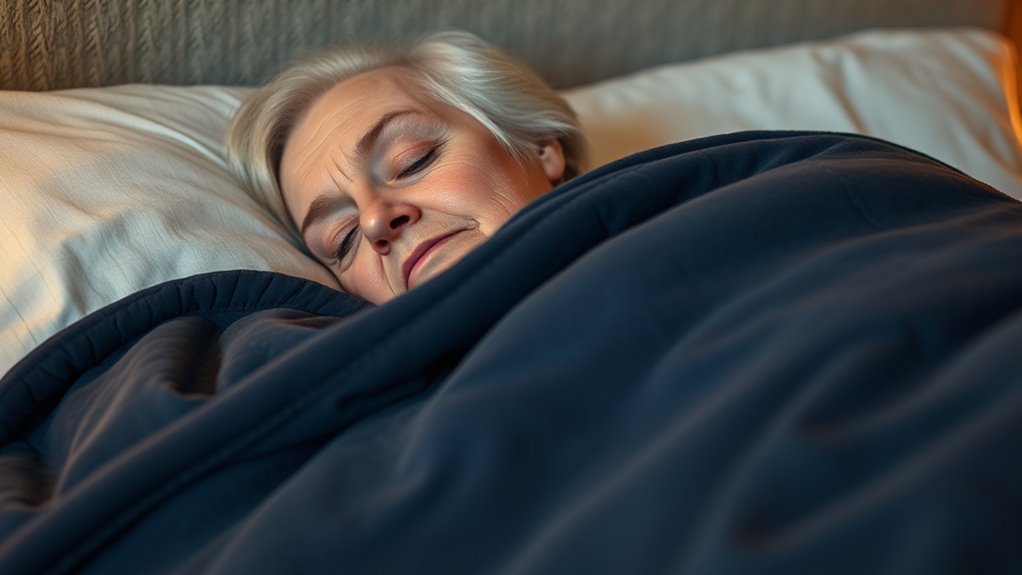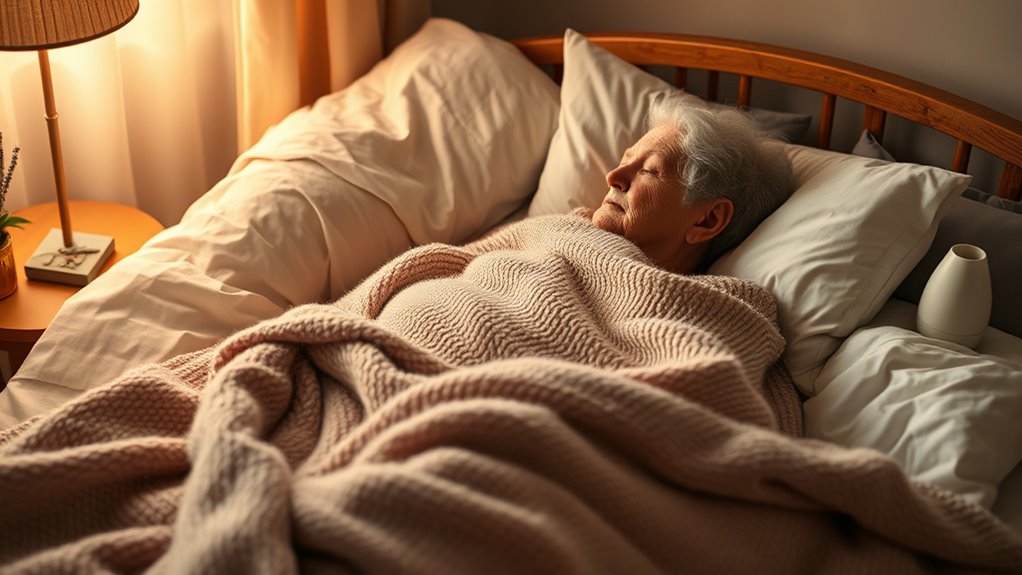Using a weighted blanket can help reduce restlessness in someone with Alzheimer’s by mimicking human touch and calming their nervous system. The gentle, even pressure promotes feelings of security, lowers stress hormones, and releases calming chemicals like serotonin and melatonin. This can lead to better sleep, fewer agitation episodes, and a calmer mood. If you want to learn more about selecting and introducing a weighted blanket effectively, keep exploring for helpful tips.
Key Takeaways
- Weighted blankets mimic human touch, providing comfort that helps reduce agitation and promote relaxation in Alzheimer’s patients.
- They activate calming neurochemical responses, lowering stress hormones and increasing serotonin and melatonin levels.
- Properly weighted blankets improve sleep quality, decrease nighttime awakenings, and extend sleep duration for individuals with Alzheimer’s.
- Introducing the blanket gradually and monitoring comfort ensures safety and maximizes benefits in reducing restlessness.
- Combining weighted blankets with other sensory strategies enhances overall emotional stability and reduces anxiety-related behaviors.
Understanding Restlessness in Alzheimer’s Disease

Restlessness is a common and challenging symptom in Alzheimer’s disease that can considerably disrupt your daily life. You might find yourself pacing, fidgeting, or feeling agitated without clear reason. This restlessness often stems from confusion, anxiety, or an inability to process stimuli properly. As the disease progresses, your brain struggles to regulate emotions and sleep, intensifying these feelings. You may find it hard to settle down or relax, which can lead to exhaustion or frustration. Restlessness isn’t just about discomfort; it affects your overall well-being and ability to rest. Understanding that it’s a symptom tied to brain changes helps you recognize it as part of Alzheimer’s. Managing these feelings becomes essential to improve your quality of life and reduce distress. One approach to addressing these issues involves environmental adjustments, which impacts overall perception of comfort and relaxation in your environment. Adjusting environmental factors, such as lighting and noise levels, can also influence the sensory processing and help reduce agitation. Additionally, incorporating calming techniques and familiar routines can further support emotional stability and reduce restlessness. Recognizing the role of brain changes in these symptoms can guide caregivers in developing effective management strategies. Incorporating essential oils for calming may also provide a natural way to soothe agitation and promote relaxation.
How Weighted Blankets Mimic Human Touch

When you use a weighted blanket, the gentle pressure feels like a comforting touch, which can help calm your nervous system. This sensation often reduces feelings of restlessness and anxiety. As a result, it promotes a sense of security, making it easier to relax and rest peacefully. Incorporating weighted blankets into a personalized investment strategy can also enhance overall well-being and security. Additionally, the protective styling benefits of using weighted blankets can support a sense of safety, especially for individuals with Alzheimer’s who may experience heightened discomfort or agitation.
Gentle Pressure Mimics Touch
Weighted blankets apply gentle, consistent pressure that closely resembles the sensation of human touch, which can have a calming effect on those with Alzheimer’s. This gentle pressure stimulates your body’s sense of contact, providing reassurance and comfort. When you’re wrapped in a weighted blanket, it creates a sense of security, mimicking the warmth and pressure of someone’s touch. This sensation can reduce feelings of anxiety or agitation that often accompany Alzheimer’s. You might notice a feeling of being hugged or held, which helps you feel more grounded and less overwhelmed. Because the pressure is evenly distributed, it avoids sudden or uncomfortable sensations, promoting relaxation. This mimicry of human touch helps establish a soothing environment that encourages rest and peace.
Calms Nervous System Responses
Because weighted blankets apply consistent, gentle pressure, they can directly influence your nervous system by activating touch receptors in your skin, which helps calm overactive responses. This gentle pressure signals your brain that you’re safe, reducing stress and anxiety levels. As a result, your nervous system shifts from a fight-or-flight state to a more relaxed, restful mode. This calming effect can improve sleep quality and reduce agitation. To understand how this works, consider the table below:
| Effect on Nervous System | Sensory Response | Resulting State |
|---|---|---|
| Activates touch receptors | Sends calming signals | Relaxation |
| Reduces cortisol levels | Lowers stress hormones | Calmness |
| Damps hyperactivity | Stabilizes nervous responses | Restfulness |
| Promotes parasympathetic response | Encourages rest and digest | Sleep readiness |
Promotes Feelings of Security
Since human touch is a fundamental source of comfort and reassurance, weighted blankets work by mimicking that soothing sensation. When you use one, the gentle pressure creates a sense of being held or hugged, which triggers feelings of security. This sensation helps reduce feelings of anxiety or vulnerability, especially in individuals with Alzheimer’s who often seek comfort through tactile contact. The evenly distributed weight provides a calming effect that reassures your brain, signaling safety and stability. As a result, you’ll likely feel more grounded and less restless. This sense of security can make it easier to relax and fall asleep, easing nighttime agitation. Ultimately, weighted blankets serve as a comforting, non-verbal way to foster emotional safety and peace of mind.
Scientific Evidence Supporting Weighted Blanket Use

Research shows that weighted blankets can improve sleep quality and help reduce anxiety in individuals with Alzheimer’s. Studies also reveal calming neurochemical effects, promoting relaxation and emotional stability. These findings support incorporating weighted blankets as a therapeutic option for restlessness. Additionally, understanding the Vortex concept can help caregivers foster a more calming environment, enhancing the overall benefits of using weighted blankets. Recognizing narcissistic traits in caregivers can also aid in providing better support and understanding for individuals with Alzheimer’s. Moreover, the stress response reduction associated with weighted blanket use can contribute to decreased agitation and improved overall well-being. A deeper understanding of neurochemical effects can further optimize therapeutic strategies for managing restlessness.
Improved Sleep Quality
Scientific studies have shown that weighted blankets can substantially improve sleep quality for individuals with Alzheimer’s disease. The gentle pressure provided by the blanket helps regulate your body’s melatonin and cortisol levels, promoting deeper, more restorative sleep. Many users report falling asleep faster and experiencing fewer night awakenings. The calming sensation reduces restlessness, allowing your body to relax fully. Improved sleep quality can also lessen daytime fatigue and confusion. Research indicates that consistent use of weighted blankets leads to longer sleep duration and better sleep efficiency. This natural approach doesn’t involve medications, making it a safer option for many. If sleep disturbances are affecting you or your loved one, incorporating a weighted blanket could be a simple yet effective way to enhance sleep quality.
Reduced Anxiety Levels
Weighted blankets have been shown to considerably reduce anxiety levels in individuals with Alzheimer’s disease. Studies indicate that the deep pressure stimulation provided by the blanket can help calm the nervous system, making you feel more secure and less overwhelmed. When you use a weighted blanket, your body responds by releasing calming neurochemicals, which helps ease feelings of worry and agitation. Many caregivers report noticeable improvements in behavior and mood after introducing weighted blankets into daily routines. The sensation of gentle pressure can mimic a comforting hug, providing reassurance during stressful moments. As a result, you may experience fewer anxiety episodes, contributing to a more peaceful and relaxed state overall. This evidence supports weighted blankets as an effective tool for managing anxiety in Alzheimer’s patients.
Calming Neurochemical Effects
When you use a weighted blanket, your body responds by releasing calming neurochemicals such as serotonin and melatonin. These chemicals help regulate mood and promote sleep, reducing restlessness in Alzheimer’s patients. Serotonin enhances feelings of well-being, while melatonin signals your body that it’s time to rest. Scientific studies show that deep touch pressure from weighted blankets stimulates the nervous system, encouraging the production of these neurochemicals. This effect can lead to improved sleep quality and decreased agitation. The table below summarizes these neurochemical benefits:
| Neurochemical | Effect on Restlessness |
|---|---|
| Serotonin | Boosts mood, reduces anxiety |
| Melatonin | Promotes sleep, decreases agitation |
Using a weighted blanket therefore supports calming neurochemical responses, easing Alzheimer’s-related restlessness.
Selecting the Right Weighted Blanket for Your Loved One

Choosing the right weighted blanket for your loved one involves considering their specific needs and preferences. First, pay attention to their size and weight. A blanket should be about 10% of their body weight for comfort and effectiveness. Next, consider fabric choices—soft, breathable materials like cotton or bamboo work well for sensitive skin. If your loved one tends to overheat, opt for a lighter weight or cooling fabrics. If they prefer a cozy feel, choose a thicker or plush material. Also, think about the blanket’s size—should cover the entire bed or just the body? Finally, make certain the blanket’s design is easy to handle and clean, making daily use simple and stress-free for both of you. Ensuring the blanket has the right weight distribution can enhance its calming effects and overall comfort.
Best Practices for Introducing a Weighted Blanket

Introducing a weighted blanket gradually helps your loved one adjust comfortably and safely. Start by placing the blanket on their lap or shoulders during calm moments, allowing them to become familiar with its presence. Observe their reactions and give them time to get used to the sensation. To facilitate a smooth transition, follow these best practices:
- Begin with short periods, like 15-20 minutes, and increase gradually.
- Use the blanket during relaxing activities, such as reading or watching TV.
- Communicate openly, encouraging your loved one to express comfort levels.
- Monitor their response closely, adjusting duration based on their tolerance.
Patience and gentle introduction help your loved one accept the blanket, making it a helpful tool to reduce restlessness.
Monitoring Comfort and Safety During Use

As you use a weighted blanket, it’s important to keep safety precautions in mind and guarantee it’s comfortable for the user. Regularly check their comfort level and watch for any signs of distress or discomfort. Also, have an emergency response plan in place to quickly address any unexpected issues that may arise. Ensuring proper environmental considerations can help minimize risks and promote a safer, more effective use of the blanket. Additionally, verifying that the weighted blanket has appropriate weight distribution can enhance comfort and safety during use. Considering the design and materials of the blanket can also impact breathability and overall safety. Incorporating safety guidelines from reputable sources can further support safe use. Staying informed about data privacy and using secure monitoring tools can help protect user information during use.
Safety Precautions Implementation
To make certain safety during weighted blanket use, monitoring the individual’s comfort and reactions continuously is crucial. Keep an eye on signs of discomfort, such as agitation or difficulty breathing. Regularly check that the blanket isn’t too heavy or restrictive. Be alert for skin irritation or pressure points, especially if the individual has sensitive skin. Ensure the blanket remains properly positioned and doesn’t shift unexpectedly.
Here are four safety precautions to follow:
- Confirm the weight is appropriate for the person’s size and needs.
- Observe for any signs of distress or discomfort.
- Check that the blanket isn’t causing overheating or sweating.
- Remove or adjust the blanket immediately if adverse reactions occur.
Comfort Level Monitoring
Monitoring comfort levels during weighted blanket use helps guarantee safety and effectiveness. As you use the blanket, pay close attention to the person’s reactions—look for signs of discomfort, such as restlessness, pulling away, or skin irritation. Ask regularly if they feel too hot, too heavy, or uncomfortable. Adjust the blanket’s weight or positioning if needed, ensuring it provides gentle pressure without causing distress. Keep communication open; even with Alzheimer’s, some individuals can express discomfort if prompted softly. Use your judgment to balance the calming benefits with the person’s comfort, stopping use if they show signs of agitation or discomfort. Regularly checking in helps you respond quickly, ensuring the blanket remains a safe and supportive tool.
Emergency Response Planning
Since emergencies can happen unexpectedly, it’s essential to be prepared to respond quickly if the person shows signs of distress or discomfort while using a weighted blanket. You should have a plan in place to guarantee their safety and comfort. Here are four key steps:
- Monitor constantly for signs of overheating, choking, or difficulty breathing.
- Keep communication open to gauge discomfort or agitation.
- Have quick-release mechanisms accessible if the blanket needs to be removed immediately.
- Know emergency contacts and have a plan to seek medical help if needed.
Staying alert allows you to act swiftly, preventing potential harm and ensuring the person remains safe and comfortable during use.
Combining Weighted Blankets With Other Therapies

Combining weighted blankets with other therapies can enhance their effectiveness in reducing Alzheimer’s-related restlessness. You might find that integrating relaxation techniques, such as gentle massage or calming music, creates a more soothing environment. Using both approaches together can amplify their calming effects and improve sleep quality. Consider this table to explore complementary therapies:
| Therapy Type | Benefit |
|---|---|
| Aromatherapy | Promotes relaxation and reduces anxiety |
| Physical Activity | Eases agitation and improves mood |
| Cognitive Stimulation | Engages the mind, reducing restlessness |
| Mindfulness & Meditation | Encourages calmness and focus |
Combining these methods with weighted blankets offers a holistic approach, addressing multiple causes of agitation and fostering a sense of security. Additionally, Ring Security Cameras can help monitor activity and ensure safety during nighttime rest. Recognizing the importance of emotional support can further enhance overall well-being and comfort in individuals with Alzheimer’s.
Addressing Common Concerns and Misconceptions

While integrating weighted blankets with other therapies can be highly effective, some concerns and misconceptions about their use often arise. You might worry that the blanket is too heavy or uncomfortable for your loved one, or that it could cause suffocation or restrict movement. Others believe that weighted blankets are only for children or that they are unsafe for seniors. It’s important to know that properly weighted blankets are designed for safety and comfort, with weights tailored to the user’s size. Here are common misconceptions:
- They’re too heavy for seniors.
- They cause suffocation or restrict breathing.
- They’re only for children.
- They can be unsafe without supervision.
Understanding these points helps you make informed decisions about using weighted blankets safely.
Personal Stories and Family Experiences

Many families have found that incorporating weighted blankets into their loved ones’ routines can make a noticeable difference in managing Alzheimer’s-related restlessness. You might hear stories of calmer nights and more peaceful mornings. One daughter shared how her mother sleeps longer and wakes less agitated after using a weighted blanket. Another family described how their father’s anxiety decreased, allowing for more meaningful interactions. These personal experiences highlight the emotional relief families feel when they see improvements. Additionally, using natural materials in weighted blankets can enhance sensory comfort and safety for Alzheimer’s patients. Incorporating pressure therapy can further promote relaxation and reduce agitation, making daily routines more manageable for caregivers. The use of gentle pressure has been shown to help calm the nervous system and improve sleep quality for those with Alzheimer’s.
Future Directions in Non-Pharmacological Management

Building on the positive results seen with weighted blankets, researchers are exploring other innovative non-pharmacological approaches to manage Alzheimer’s-related restlessness. These strategies aim to improve quality of life without medication. Here are some exciting directions:
Exploring innovative, drug-free strategies to ease Alzheimer’s-related restlessness and enhance quality of life.
- Sensory Stimulation: Using music, aromatherapy, or tactile activities to calm agitation and promote relaxation. Incorporating sensory processing techniques can further enhance calming effects. Additionally, integrating tableware in therapeutic activities may provide familiar and comforting sensory input for some patients.
- Environmental Modifications: Adjusting lighting, noise levels, and room layouts to create a soothing setting.
- Personalized Activities: Tailoring routines and engagement based on individual preferences and history.
- Technology-Based Solutions: Implementing virtual reality or wearable devices to monitor and gently soothe patients.
- Understanding Behavioral Triggers: Recognizing and addressing specific triggers such as emotional distance or irritability can further enhance management strategies.
These approaches hold promise for safer, more effective management of restlessness, emphasizing comfort and dignity.
Frequently Asked Questions
Are Weighted Blankets Suitable for All Stages of Alzheimer’S Disease?
You wonder if weighted blankets are suitable for all stages of Alzheimer’s. While they can help reduce agitation and improve sleep, they might not be ideal for everyone, especially in advanced stages where safety becomes a concern. You should consult with a healthcare professional to determine if a weighted blanket’s benefits outweigh any risks for your loved one, and always supervise them to prevent discomfort or injury.
How Do I Clean and Maintain a Weighted Blanket Safely?
You might notice that proper cleaning and maintenance are key to keeping your weighted blanket safe and comfortable. Always check the care label for specific instructions; most are machine washable on gentle cycles. Use mild detergent, avoid bleach, and air dry or tumble dry on low heat. Regularly inspect for tears or loose fillings, and store in a cool, dry place. Staying diligent guarantees your blanket remains hygienic and effective for its purpose.
Can Weighted Blankets Cause Dependency or Reduce Natural Sleep Habits?
You might wonder if weighted blankets cause dependency or affect your natural sleep habits. While some worry about becoming reliant, most people find them safe when used appropriately. They don’t interfere with your sleep cycle or create dependency. Instead, they can promote relaxation and improve sleep quality. Just make sure to use a blanket that’s the right weight and follow safe guidelines, so you benefit without risking any negative effects.
What Are Signs That a Weighted Blanket Is Not Working Effectively?
Think of your sleep routine as a garden—you want to see healthy growth. If your weighted blanket isn’t working, you might notice increased restlessness, tossing and turning, or waking frequently during the night. You could also feel more anxious or find it hard to fall asleep despite using the blanket. If these signs persist, it’s a good idea to reassess whether the blanket provides the comfort you need or explore other calming strategies.
Are There Specific Materials Better for Individuals With Sensitive Skin?
When choosing a weighted blanket for sensitive skin, you should look for natural, hypoallergenic materials like organic cotton or bamboo. These fabrics are softer and less likely to cause irritation. Avoid synthetic fibers or blends that might cause discomfort. Always check the product labels and opt for covers specifically designed for sensitive skin. Testing a small area first can help prevent any allergic reactions or irritation.
Conclusion
So, while we often turn to medication for Alzheimer’s restlessness, sometimes the simplest solutions—like a weighted blanket—can make the biggest difference. Ironically, what feels like a cozy hug might just be the comfort your loved one needs to find peace. Instead of chasing elusive cures, maybe it’s time to embrace these gentle, non-invasive options. After all, a little weight and a lot of care might be the best medicine we overlook.









